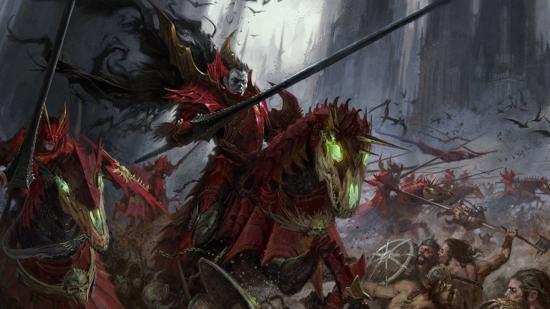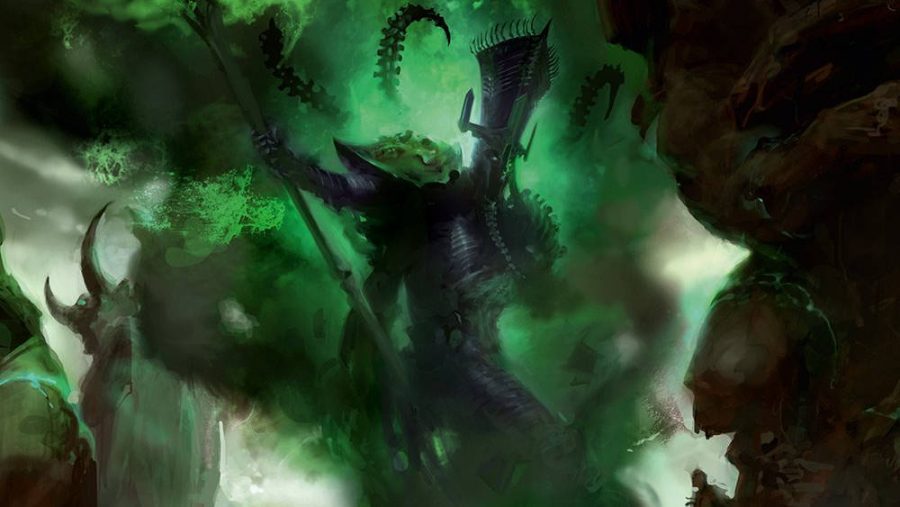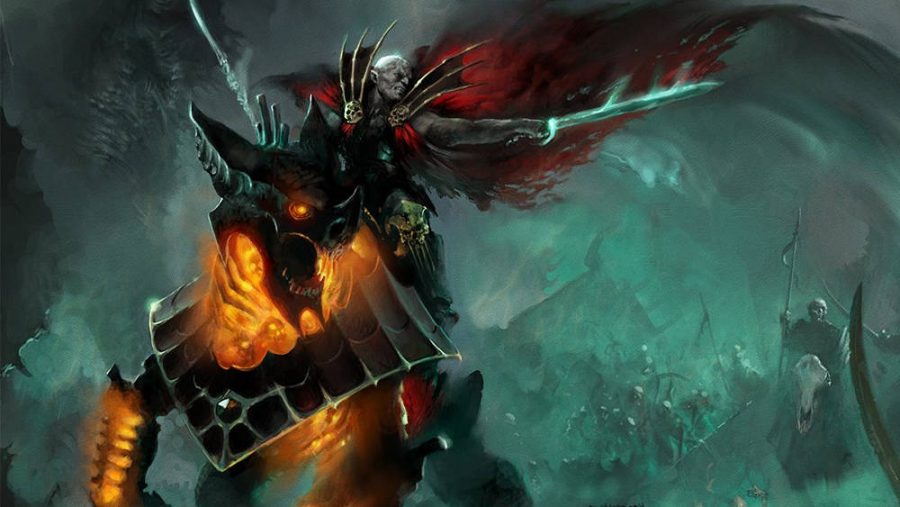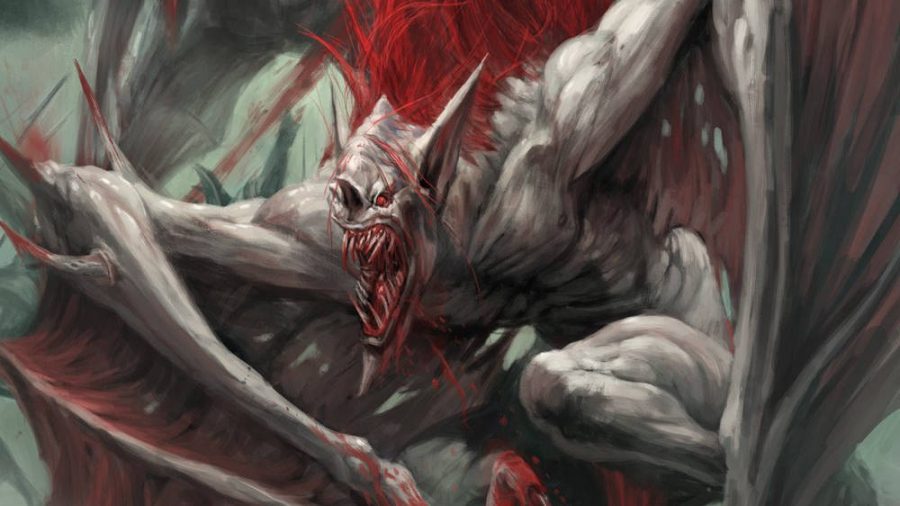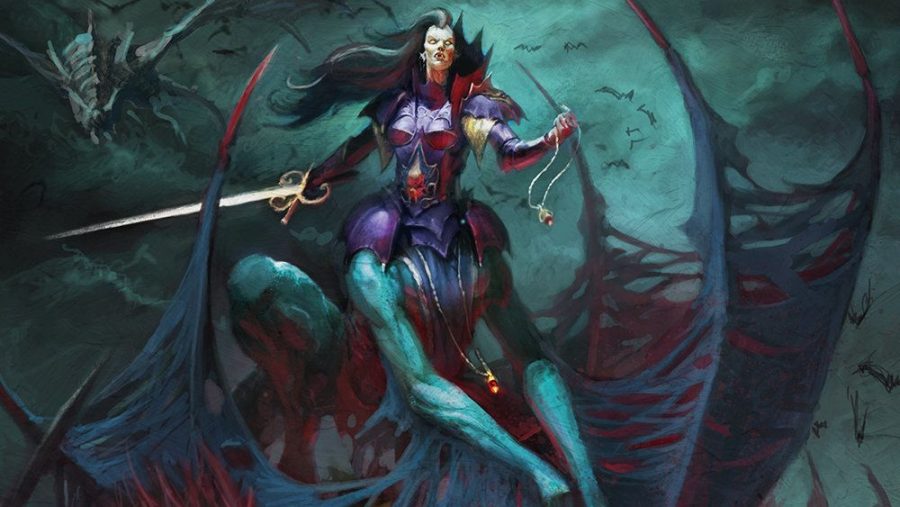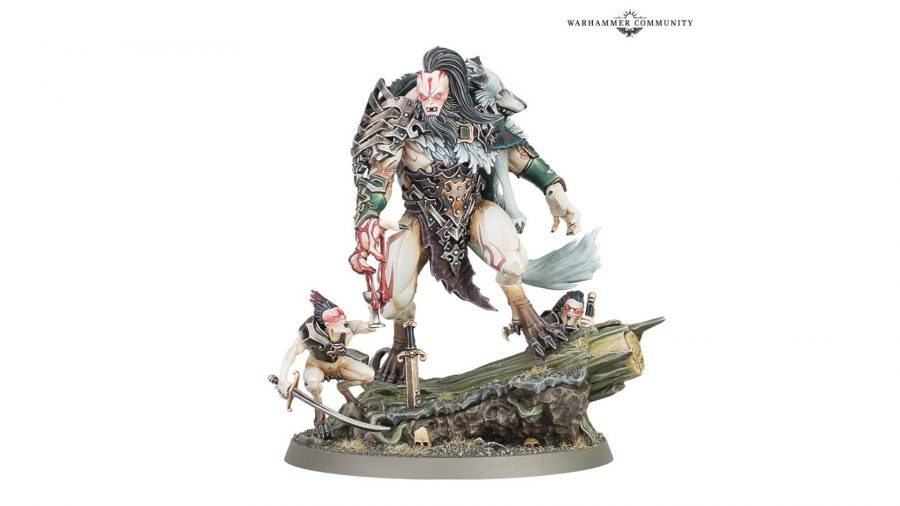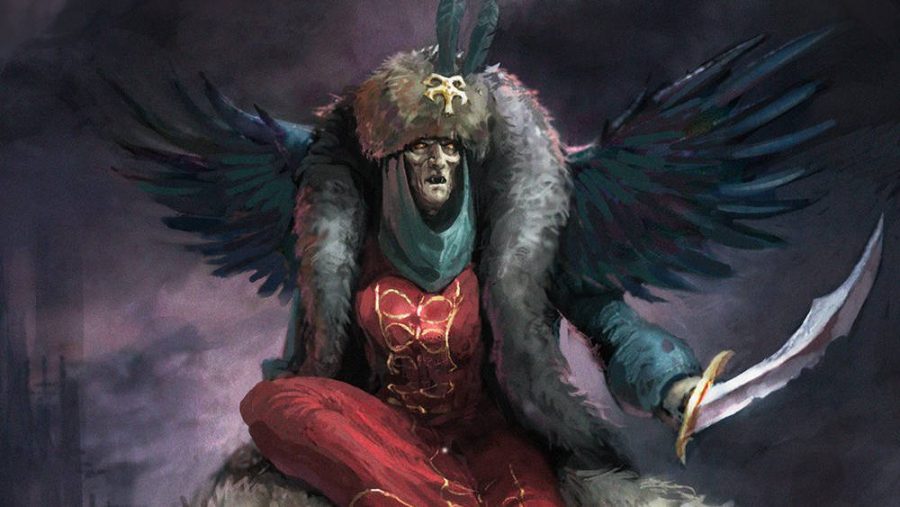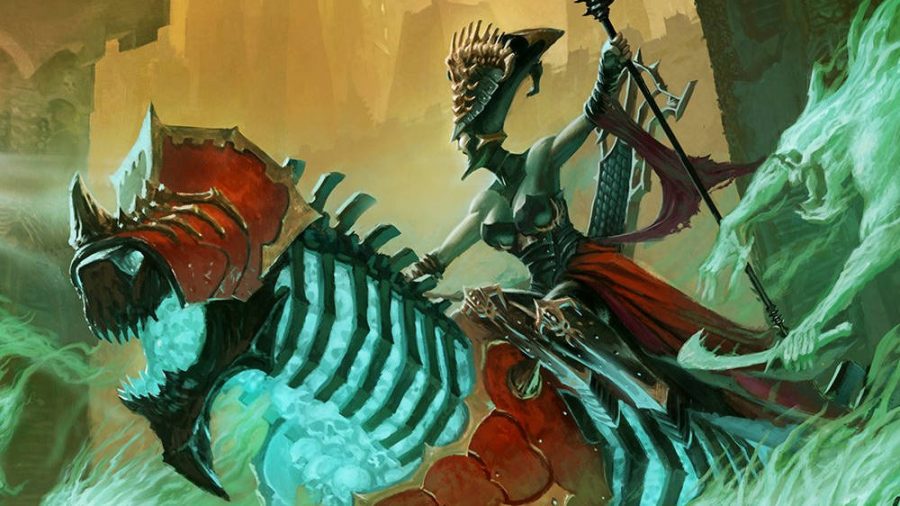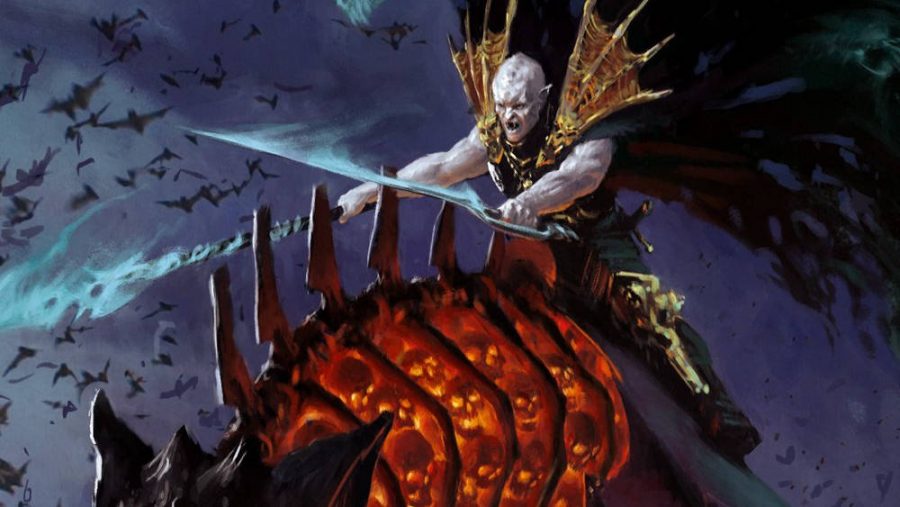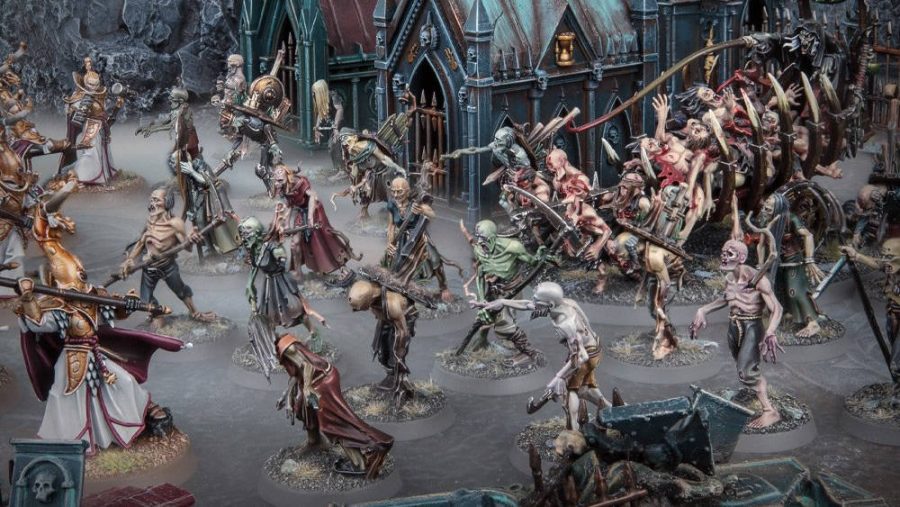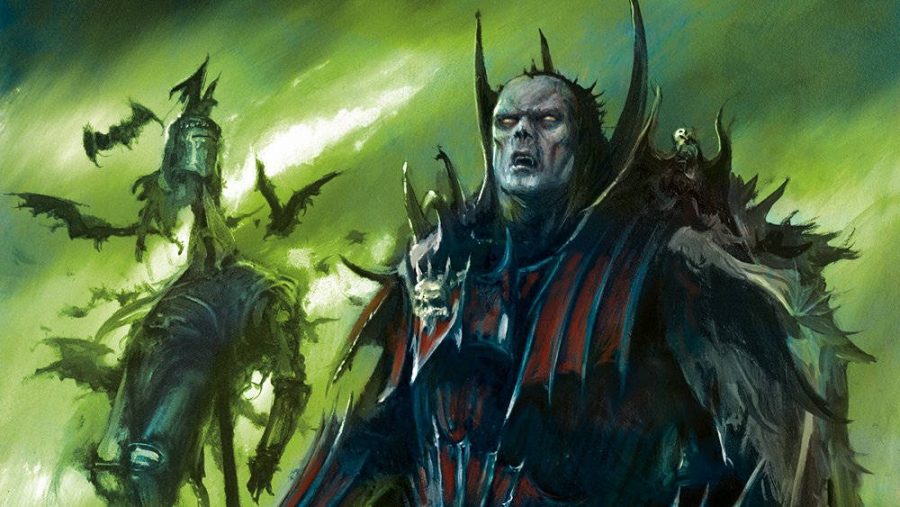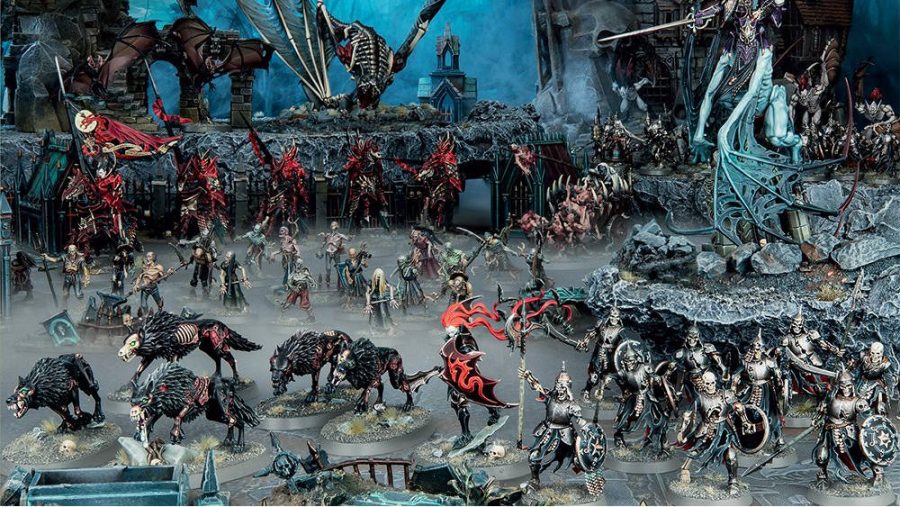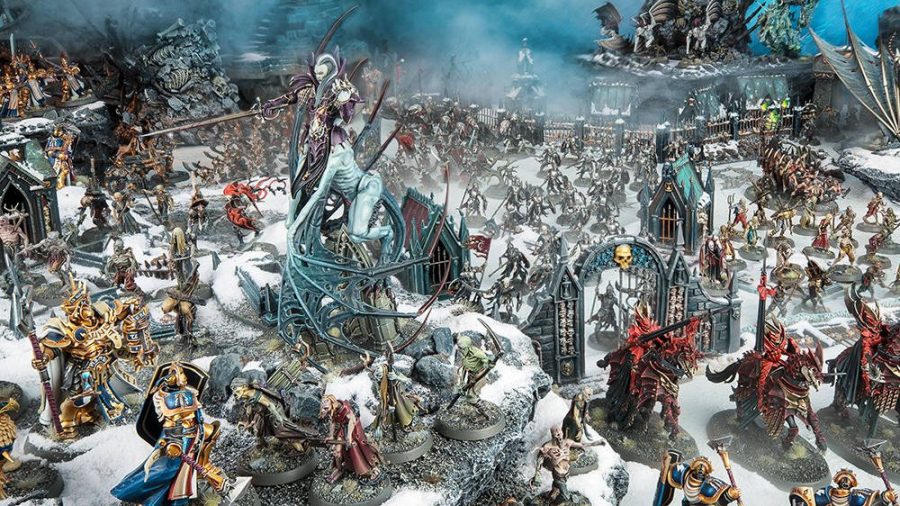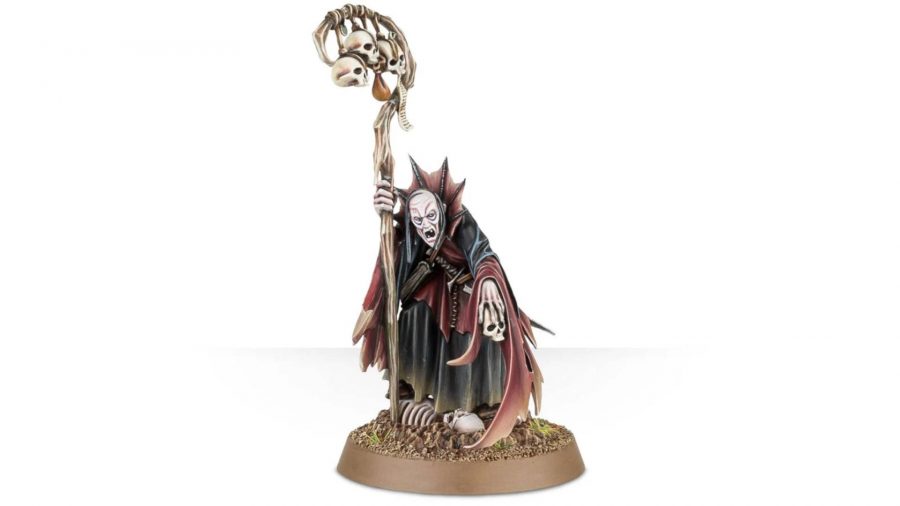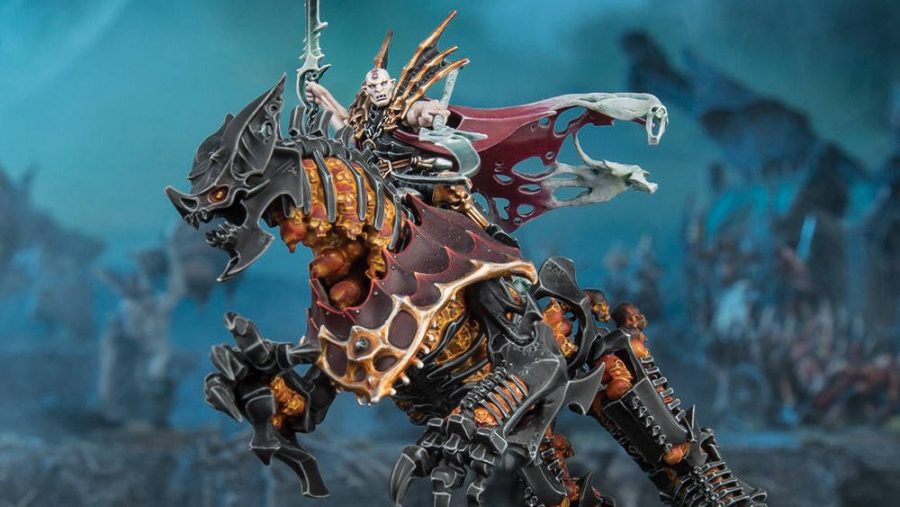Grab a wooden stake, pray for Sigmar’s blessing, and get inside the nearest Stormkeep, because the vampires are back in town. Age of Sigmar’s answer to Warhammer Fantasy’s Vampire Counts, the Soulblight Gravelords are the elite-tier of Nagash’s deathly force. All fangs, flair, and feasting, these vampires are as macabre as they are malignant.
Grown from the twisted belly of Victorian gothic horror, the pallid bloodsuckers share an air of aristocratic opulence with their literary cousins. Ancient vampiric dynasties command armies of lesser undead beings, cursing the living and raising the dead into brutal submission. Great vampire lords build vast empires, scheming in sycophantic courts to overthrow their undead kin and climb the hierarchy of the damned.
The last faction to release before the launch of Age of Sigmar third edition, the Soulblight Gravelords represent a reimagining of the Vampire Counts of old, a replacement of the tired Legions of Nagash, and a brand new army in their own right. If ranks of shambling skeletons, bloodthirsty beasts, arcane magic, and the colour red appeal, these ghouls should make you feel right at home.
If you’re interested in a broader overview of the fantastical factions that call the Mortal Realms home, have a read of our Age of Sigmar armies guide. But if the sight of immortal fiends doesn’t shake your bones, then read on.
Soulblight Gravelords Lore
As with all factions loyal to the Grand Alliance of Death, the history and happenings of the Soulblight Gravelords are intimately connected to the Mortal Realms’ resident reaper, Nagash. Before Warhammer’s Old World was obliterated and reborn into the Age of Sigmar, vampires stalked the land at the behest of the Supreme Lord of Undeath, reluctantly following his commands and scheming among themselves.
Foremost among them was Neferata. A queen, before the corrupted necromancy of Nagash twisted her mind, Neferata was the first Soulblight vampire. Attempting to replicate the Elixir of Life, she distilled a corrupted version, granting herself eternal youth, immense physical prowess, heightened senses, and magical aptitude, all at the cost of an insatiable thirst for blood. More aggravatingly, however, was her unceasing connection to Nagash, forever compelling her loyalty to the dark lord.
But where Neferata saw an opportunity for unrivalled power, Nagash saw a pawn to wield for his own malignant deeds. More vampires were sired, and left to autonomously satiate their thirst while expanding the touch of death to all corners of the realms.
In the centuries later, vast lineages formed, splitting into various dynasties and empires of distinct cultures. Some cherished the deathly powers of Nagash, revering him as a god to be worshipped, while others rejected him, only resentfully supporting his deathly crusade as they were forever cursed to do. All, however, conspired against one another, currying favour with those who would help them, before betraying any ally that stood as an obstacle to undead hegemony.
Rat-men: Check out our Age of Sigmar Skaven guide
Some vampires were bestial and crazed, bound to leap upon any mortal that passed them by. Others attempted a modicum of civility, building great cities to generate production lines of fresh meat. Others still lurked in the shadows, keeping their courts hidden from the forces of Chaos and human encroachment.
When the World-That-Was fractured into cosmic shards, the Soulblight didn’t vanish. Neferata hid deep within the Realm of Shyish, watched over by Nagash. Embedded within such an inhospitable environment that even Chaos dared not venture into her abode, she survived to restart her quest for power. Nagash, meanwhile, returned the slain Mannfred von Carstein – an infamous vampire lord of the Old World – to unlife, and reinstated his two Mortarchs as his prime champions.
In the Age of Sigmar, the Soulblight Gravelords have again split into several dynasties. Foremost among them are the Vyrkos, Kastelai, and Avengorii clans, each with a distinct bloodline curse and magical proclivity. Submissive to a powerful patriarch or matriarch at their head, some follow the will of Nagash and attempt to prove their worth to his Mortarchs. Others pursue their bloodlust above all, ignoring the grander quarrels of their accursed kin.
Scheming, back-stabbing, and courtly rivalries aside, the Soulblight Gravelords are not the kind of terrors you’d like to meet on a dark night.
Soulblight Gravelords characters
Many popular vampires graced the lore of Warhammer Fantasy Battle. That hasn’t changed in the Age of Sigmar. Many characters in the previous cast of pallid bloodsuckers have been wiped away, though, leaving a fresh plate of fanged fiends to take their place.
When the Soulblight Gravelords army launched, GW didn’t hold back in the character model department. These are the primary Soulblight characters you should be aware of:
Lauka Vai
Queen of the Avengorii dynasty, Lauka Vai represents all the best features of her vampiric followers: a monstrous physique so warped it grants her the unmatched strength of a beast. Originally a monster-hunting knight, a chance encounter with prime splicer Tzeentch left her a half undead-bat-drake-monster, perpetually torn between the primal instincts of her monstrous half and noble origins.
Lauka Vai sits at odds with the rest of the Avengorii clan. A dynasty that embraces the bestial side of vampirism, and forgoes any semblance of human civility, they’re most comfortable around Vargheists and Fell Bats. Lauka Vai, meanwhile, clings onto the noble world of knighthood she once knew, while satiating that ever-creeping thirst.
Radukar, the Beast
First showing up in Games Workshop’s ill-fated Cursed City boxed dungeon-crawler, Radukar is a vampire lord with a celebrated history. Earning the vampiric touch as a reward for proving his beast-slaying talents, he later invaded Ulfenkarn to liberate the city from Khorne’s grasp.
Setting up shop in the city and ingratiating himself with its nobility, things turned ugly after Nagash unleashed a shockwave of death magic across the Mortal Realms. Radukar’s vampiric thirst grew, before he turned against the city and subjected its populace to the jaws of his vampiric court. A few years of brutal submission and decadent gorging later, he was unceremoniously booted out of its walls by a band of do-gooders.
A hideous transformation turned him into a hybrid monster that ravages the landscape with unfettered rage. Hardly the skilled warrior he once was, tearing and clawing are all he knows now.
Belladamma Volga,
Vampires and werewolves join forces in Belladamma Volga. The dreaded matriarch of the Vrykos Soulblight bloodline, old Mrs Volga is the only leader of a vampiric dynasty to not owe her cursed powers to Nagash. Instead, an ancient ‘godbeast’ is responsible for her bloodline’s distinctly lupine curse, which manifests in not only a wolfish appearance but an intimate connection to rabid animals.
Spray and pray: Read our guide to painting miniatures
Dire wolves flock to her, ready to carry out her mischievous deeds. Even her favoured alpha wolf steed, is said to be her previous, unfortunate beau – whether the Soulblight curse transformed him into a four-legged beast, or Belladamma’s rage got the best of her, we don’t know and we dare not ask.
Neferata
The big bad. The original. The vampire to end all vampires. Neferata was the first mortal to fall to vampirism in the Old World and casts a long reach across the ancient history of the undead bloodsuckers. In Age of Sigmar, she was brought back to unlife by Nagash – alongside Mannfred and Ushoran – as his Mortarch of Blood. Hers is the usual schtick: commanding the colossal forces of the Blood Legion to conquer the Mortal Realms and strip it of all life.
But she’s no willing servant. A begrudging follower of Nagash, she’s always looking to usurp his godly powers, and position herself as the single ruler of Death. The Soulblight curse forever compels her loyalty to the Supreme Lord of Undeath, and ensures her attempts to break free from his thrall are doomed to failure. Taking a portion of Shyish for herself, she’s built an empire that follows her will, replete with a devoted population to do her bidding.
Despite her enmity for Nagah, she’s not the hot-headed beast that some of her Soulblight cousins act like. Relying on a complex network of spies and political infiltrators, Neferata weaves her will through enemy factions, fracturing entire dynasties and swooping up their power to inflate her own standing. Petty grievances are not forgotten, but left to fester into justifications for war.
Mannfred von Carstein
A fan-favourite of the Vampire Counts, Mannfred von Carstein is Age of Sigmar’s take on the classic Transylvanian, Bram Stoker-esque vampire lord. The Mortarch of Night, he has the usual Soulblight penchant for scheming, conspiring, and conniving, but is the closest anyone will likely get to becoming the Undying King’s right-hand man. A brutal ruler and effective warlord, Mannfred is Nagash’s ace in the hole when it comes to territorial conquest.
In the Old World, Mannfred backstabbed his way up the vampiric hierarchy, eventually coming to rule over a personal realm and attempting to brutally subject all of humanity to his thrall. When the End Times came, he stuck to his usual selfish temperament, betraying Nagash for the forces of Chaos. While he hoped to weaken both sides and create foundations for his own control, he did little more than open the floodgates, directly on himself.
Colour galore: These are the best paints for miniatures
Returned to Age of Sigmar by Nagash’s deathly embrace, Mannfred carved out a little piece of Shyish to call his home, setting up another empire that has all the tropes of gothic literature: tall castles, dark skies, and lots of spires. Populated by undead servants, their decaying flesh is twisted to look like Mannfred’s defeated rivals, completing the ultimate – albeit horrendous – trophy display case.
He’s no pal of Neferata, though. The two Mortarchs have a history of jostling for influence of the Soulblight legions. While Neferata sees control as a means of inflating her own worldly power, Mannfred is more interested in earning the favour of Nagash to elevate his lot.
Playing the Soulblight Gravelords in Age of Sigmar
The Soulblight Gravelords are a varied bunch. Although every army will have the same few staple units at its core, there’s heaps of customisation and strategic variety to bleed from their character units and subfaction choices. Thematic faction abilities provide playstyles you won’t find elsewhere in the Mortal Realms, and place their beefy vampire lords front and centre.
Unlike fragile armies, for which even the loss of a single Battleline unit can be a vast blow, the Soulblight are a little more frivolous with their forces. The Unquiet Dead ability lets you place four ‘gravesites’ across the battlefield at the start of the game, marking locations to summon reinforcements mid-battle. It’s an effective means of pushing units directly into the fray when you need them most.
But it really shines in combination with Endless Legions. Offering you a chance to resurrect Deadwalker Zombies or Deathrattle Skeletons, and plonk them at the gravesites, it lets you happily throw units at the enemy line, safe in the knowledge they’ll soon be brought back in fighting spirits.
Add to that their Deathless Minions ability, which lets you negate the Wounds and Mortal Wounds inflicted on a Soulblight unit within 12 inches of a gravesite on a 6+ roll, and your troops will be sticking around for a long time. Make sure to place down your gravesites at key positions – particularly in the vicinity of objective markers – and you’ll hand yourself a permanent advantage across the match.
Future tidings: Our Warhammer 40k Imperium factions guide
While these abilities are available for all Soulblight armies, the choice of your army’s ‘Cursed Bloodline’ will open even more experimental possibilities. All have some gameplay quirk that ties to their thematic origins, and will influence your army’s playstyle. Legion of the Night, for instance, grants +1 to your save rolls for all Deadwalker and Deathrattle units in the first turn, and lets you keep half your units to deploy as reserves. It’s a great option if you like malleable tactical plays, and want to start the battle one foot forward.
The Vyrkos Dynasty, meanwhile, is better suited to spell-casting armies, letting you redo casting rolls for all your vampire wizards. Add in a suite of magic-focused Battle Traits, alongside Command Traits that boost the martial ability of your squishier units, and it makes for a nicely well-rounded force.
Whichever bloodline tickles your fancy, you’re going to rely on a few choice units. Deathrattle Skeletons and Deadwalker Zombies will likely make the bulk of your force. Synergising with many hero model keywords and subfaction abilities, they’re the standard troops of a Soulblight army. Not overly effective on their own, nor utilising the various effects of other horde armies, you’ll be relying on gravesites and troop refreshment to keep them in the game.
Blood Knights are the next fan favourite. Elite cavalry adept at swift movement and charging enemy flanks, they’ll sit nicely in any Soulblight army, and will be relied upon to deliver the hard-hitting punches. The Kastelai Dynasty makes particularly effective use of them, fielding the knights as battleline units and boosting their damage against Hero and Monster targets.
To make the most of your force, align its units with your army’s Bloodline. Don’t go fielding lots of Deadwalkers if you’re playing the monster-obsessed Avengorii Dynasty, or sticking lots of Fell Bats with the Vyrkos. There’s little you can do Wrong, per se, but help yourself out by marrying your troops to your subfaction. It matters with the Soulblight more than most.
The Soulblight Gravelords can be a difficult army to field. Balancing their squishy horde units and punchy elites, as well as leveraging their powerful subfaction abilities to full effect is a tall order. But their character-driven rules and variety of martial to magical abilities makes them an enjoyable force to play.
Building a Soulblight Gravelords army
Whether you’re a fresh face in the Mortal Realms or an experienced with Age of Sigmar, collecting a force of Soulblight Gravelords is a grand idea. Not only can they hold their own against any army, but their models are plain gorgeous. From shambling skeletons, to dignified vampire counts, to monstrous beasts, they perfectly capture the weird horror of Age of Sigmar’s low fantasy world.
While Start Collecting! boxes often offer a fabulous roster of minis for the budding army-builder, the Soulblight Gravelords’ is a little lacking. A rebranded version of the Legions of Nagash box, it doesn’t offer any of the staple units you’ll be bound to rely on. Instead, pick up a box of Deadwalker Zombies and Deathrattle Skeletons. The Deadwalkers will be the expendable meat sacks of your army, slowing down enemy units to grant your more valuable, heavier troops time to outflank them.
Deathrattle Skeletons serve much the same purpose, but are hardier. They’ll take down a few units while holding the line, and will soon be back in action through your well-placed gravesites, restarting the cycle of stop-kill-die all over again.
For your first leader, you can’t go wrong with a Necromancer. Not a flashy offensive pick, it’ll sit nicely in your middle ranks, buffing your nearby zombies and skeletons. Vanhel’s Danse Macabre grants a second attack to a summonable unit (in effect zombies or skeletons) within a pretty huge 18 inches, while Undead Minions lets you transfer Wounds and Mortal Wounds to any nearby summonable Soulblight units.
It’s a tight combo that lets you sink wounds into your Deadwalkers sponges, while boosting the viability of your Deathrattle Skeletons. It’s also a style that will work well with any Soulblight army, so won’t be a wasted investment once you want to boost your forces with some more expensive picks.
Cosmic corruption: Our Warhammer 40k Chaos factions guide
These three will make the backbone of a respectable Soulblight force. Throw in a set of Blood Knights, however, and the potential of your army will skyrocket. The cavalry will shred Battleline units with ease, and can face off against more elite units without batting an eyelid. Leverage their speed and durability for full effect. Don’t get bogged down hacking away turn after turn, but be sure to let your zombies act as speed bumps while your cavalry comes in from the rear.
From there, your picks are best decided by your thematic tastes. If you’re obsessed with the Belladamma Volga or Radukar character models, you can inflate the somewhat meagre attacks of the Fell Bats and Dire Wolves.
Overall, Mannfred von Carstein fares as the best character pick. Use his Mortarch of Night ability to teleport around the battlefield, escaping any bloodbaths that look to have him supplying most of the red stuff. He plays beautifully with the Blood Knights, too, and will allow you to construct an aggravatingly mobile elite force that can dart in and out of attacks, while your squishier zombies and skeletons bog down the enemy.
Regardless of which Bloodline or character model appeals, the core collection of zombies, skeletons, Necromancer, and Blood Knights will prepare the foundations of any burgeoning Soulblight Gravelords army. Go forth, and spread your curse!
